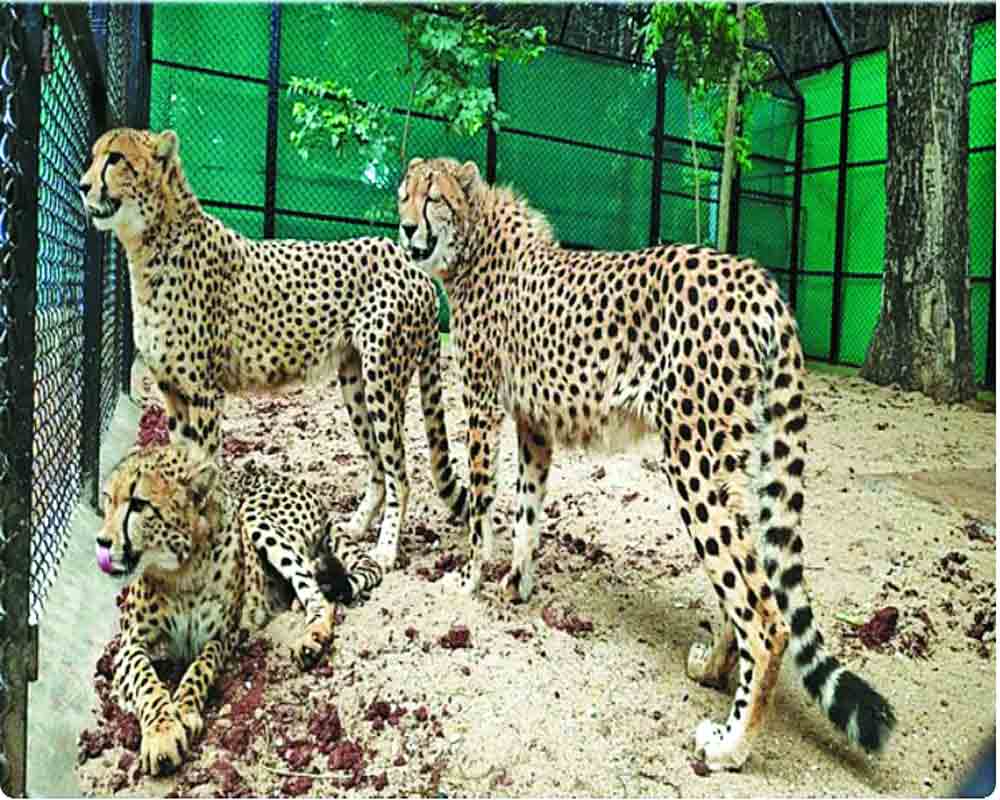Wildlife conservation cannot be achieved by ad hoc measures, it should involve people and have a grounded policy framework
The African cheetahs arrived in India earlier this month amid great fanfare and political hoopla. They have been kept in an enclosed area for now but will soon be released in the hope that they will boost efforts to conserve India’s threatened and largely neglected grasslands. However, many wildlife conservationists believe that the introduction of these cheetahs not only goes against national conservation priorities but will also not have any impact on protecting grasslands and open forest ecosystems as has been claimed. Conservation scientists like Ravi Chellam contend that a quicker and more efficient way to conserve the grasslands would be to stop categorising them as wastelands and delete them from the Wasteland Atlas of India. This would enable a more focused conservation plan for them.
But has protecting habitats always been the prime consideration behind all decisions related to wildlife conservation? If yes, why was the Galathea National Park, an iconic nesting site of the leatherback sea turtle, located in the Great Nicobar Island, denotified in 2021? Entire sanctuaries have been denotified and erased off the map of India in the name of development, says Prerna Bindra, author and former member of, the National Board for Wildlife. The denotification of the Galathea National Park coincided with the development plans for Great Nicobar put forward by the NITI Aayog, the government’s public policy think tank. Little thought was given to where the leatherbacks would nest once their site was destroyed for a shipping project and how this would accelerate the steep decline in their population, contends Bindra.
Securing the Wild
Protecting habitats for the leatherback turtles assumes critical importance as their numbers are decreasing sharply. These are the world’s largest turtles and the only species without scales and a hard shell. Named after their tough rubbery skin, leatherback turtles have existed in their current form since the age of the dinosaurs. As leatherbacks are migratory, some of them swim over 10,000 miles a year between nesting and foraging grounds. The chances of survival for these turtles making this arduous journey and then finding their nesting grounds destroyed are bleak.
Shouldn’t this project have been stopped by the National Board for Wildlife (NBWL), the government institution constituted to protect wildlife, sanctuaries, and parks? Bindra points out that instead of exercising its authority and taking corrective action, the NBWL allowed this to happen.
While denotification of the Galathea National Park could not be prevented, a move to denotify a wildlife sanctuary in Himachal Pradesh to set up a cement factory was scuttled thanks to a newspaper report by award-winning veteran journalist Usha Rai.
Why Stories Are Important
This was not the only time Rai used her pen to stop the destruction of wildlife in the name of development.
It was Rai’s story on how the rich and powerful like industrialist Sameer Thapar, owner of JCT Mills, Phagwara, would fly in helicopters and shoot at wildlife in the Corbett National Park that sent shockwaves across the country with the issue even being raised in Parliament. A case was lodged against Thapar for flouting environmental norms by landing a helicopter inside the Corbett Tiger Reserve, a protected area.
These interesting stories and revelations are part of an absorbing book that chronicles fifty years of the Wildlife Protection Act 1972 through lived experiences ofconservationists, government officials, award-winning environment and development journalists, photographers, biologists, ecologists, researchers and environmental lawyers. This is what makes the book, titled Wildlife India @50, a great read. Edited by Manoj Kumar Misra, a former Indian Forest Service officer, this 517-page Rupa
Conservation Champions
It is a fact that policies alone cannot protect wildlife. An informed community is perhaps the biggest conservation champion. This has been seen over and over again across the country. In Arunachal Pradesh had it not been for the commitment of the community, the red panda, an endangered species, found only in the eastern Himalayas, may have become extinct much like the cheetahs. Engaging the community constructively has worked not only in Arunachal Pradesh but also in Kerala. Realising the importance of tapping the potential of the community in planning and management of conservation of wildlife habitats paid rich dividends in Kerala’s Parambikulam Tiger Reserve. Making forest management inclusive and participatory was key to sustaining the protection of wildlife habitats. For the first time, forestry students, local scientists, naturalists, photographers, and the local tribal community along with the staff of the Reserve were involved in planning which areas needed to be categorised as buffer zones.
The sixth assessment report of the Intergovernmental Panel on Climate Change (IPCC) has underlined that India’s human vulnerability. Climate change coupled with a ‘development-at-any cost’ attitude is a double whammy for India’s fragile ecosystem and wildlife.
(The author is a journalist writing on development and gender. The views expressed are personal.)


























